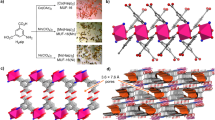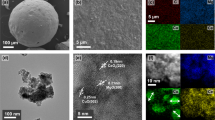Abstract
The development of inexpensive porous solid sorbents, such as porous carbons, that can selectively capture carbon dioxide (CO2) from natural gas wells is essential to reduce emission of CO2 to the atmosphere. However, at higher pressures, the selectivity for CO2 over that for methane (CH4) remains poor. Here we show that H2O can be imbibed within asphalt-derived porous carbon, with a surface area of 4,200 m2 g−1, to generate a hydrated powder material. While maintaining a high CO2 uptake capacity of 48 mmol g−1 (211 wt%), the molar selectivity for CO2 over CH4 increases to >200:1 and the H2O remains within the pores on repeated cycling. To mimic realistic natural gas wells, we used a 90% CH4 and 10% CO2 gas mixture and showed selective CO2 separation at 20 bar. Furthermore, in situ vibrational spectroscopy reveals the formation of an ordered matrix within the pores consisting of gas hydrates.
This is a preview of subscription content, access via your institution
Access options
Access Nature and 54 other Nature Portfolio journals
Get Nature+, our best-value online-access subscription
$29.99 / 30 days
cancel any time
Subscribe to this journal
Receive 12 digital issues and online access to articles
$119.00 per year
only $9.92 per issue
Buy this article
- Purchase on Springer Link
- Instant access to full article PDF
Prices may be subject to local taxes which are calculated during checkout




Similar content being viewed by others
References
Feron, P. H. M. & Hendriks, C. A. CO2 capture process principles and cost. Oil Gas Sci. Technol. 60, 451–499 (2005).
Olajire, A. A. CO2 capture and separation technologies for end-of-pipe applications–a review. Energy 35, 2610–2628 (2010).
Howarth, R. W., Santoro, R. & Ingraffea, A. Methane and the greenhouse-gas footprint of natural gas from shale formations. Clim. Change 106, 679–680 (2011).
Kenarsari, S. D. et al. Review of recent advances in carbon dioxide separation and capture. RSC Adv. 3, 22739–22773 (2013).
Ruthven, D. M., Farooq, S. & Knaebel, K. S. Pressure Swing Adsorption (Wiley-VCH, New York, 1993).
Reynolds, S. P., Ebner, A. D. & Ritter, J. A. New pressure swing adsorption cycles for carbon dioxide sequestration. Adsorption 11, 531–536 (2005).
Choi, S., Drese, J. H. & Jones, C. W. Adsorbent materials for carbon dioxide capture from large anthropogenic point sources. ChemSusChem 2, 796–854 (2009).
D’Alessandro, D. M., Smit, B. & Long, J. R. Carbon dioxide capture: prospects for new materials. Angew. Chem. Int. Ed. 49, 6058–6082 (2010).
Chowdhury, P., Bikkina, C. & Gumma, S. Gas adsorption properties of the chromium-based metal organic framework MIL-101. J. Phys. Chem. C 113, 6616–6622 (2009).
Rochelle, G. T. Amine scrubbing for CO2 capture. Science 325, 1652–1654 (2009).
Nugent, P. et al. Porous materials with optimal adsorption thermodynamics and kinetics for CO2 separation. Nature 495, 80–84 (2013).
Chen, K.-J. et al. Tuning pore size in square-lattice coordination networks for size-selective sieving of CO2. Angew. Chem. Int. Ed. 55, 10268–10272 (2016).
Kang, S. P., Lee, J. & Seo, Y. Pre-combustion capture of CO2 by gas hydrate formation in silica gel pore structure. Chem. Eng. J. 218, 126–132 (2013).
Babu, P., Linga, P., Kumar, R. & Englezos, P. A review of the hydrate based gas separation (HBGS) process for carbon dioxide pre-combustion capture. Energy 85, 261–279 (2015).
Babu, P., Kumar, R. & Linga, P. Medium pressure hydrate based gas separation (HBGS) process for pre-combustion capture of carbon dioxide employing a novel fixed bed reactor. Int. J. Greenhouse Gas Control 17, 206–214 (2013).
Zhang, Z. et al. CO2 sorption in wet ordered mesoporous silica kit-6: effects of water content and mechanism on enhanced sorption capacity. Adsorption 20, 883–888 (2014).
Billemont, P., Coasne, B. & Weireld, G. D. Adsorption of carbon dioxide, methane, and their mixtures in porous carbons: effect of surface chemistry, water content, and pore disorder. Langmuir 29, 3328–3338 (2013).
Sun, Y., Wang, Y., Zhang, Y., Zhou, Y. & Zhou, L. CO2 sorption in activated carbon in the presence of water. Chem. Phys. Lett. 437, 14–16 (2007).
Wang, Y., Zhou, Y., Liu, C. & Zhou, L. Comparative studies of CO2 and CH4 sorption on activated carbon in presence of water. Colloids Surf. A 322, 14–18 (2008).
Babu, P., Kumar, R. & Linga, P. Pre-combustion capture of carbon dioxide in a fixed bed reactor using the clathrate hydrate process. Energy 50, 364–373 (2013).
Zhou, J., Su, W., Sun, Y., Deng, S. & Wang, X. Enhanced CO2 sorption on ordered mesoporous carbon CMK-3 in the presence of water. J. Chem. Eng. Data 61, 1348–1352 (2016).
Liss, W. E., Thrasher, W. H., Steinmetz, G. F., Chowdiah, P. & Attari, A. Variability of Natural Gas Composition in Select Major Metropolitan Areas of the United States. Gas Research Institute Report No. GRI-92/0123 (American Gas Association Laboratories, Cleveland, 1992).
Smith, D. H., Wilder, J. W. & Seshadri, K. Thermodynamics of carbon dioxide hydrate formation in media with broad pore-size distributions. Environ. Sci. Technol. 36, 5192–5198 (2002).
Jalilov, A. S. et al. Asphalt-derived high surface area activated porous carbons for carbon dioxide capture. ACS Appl. Mater. Interfaces 7, 1376–1382 (2015).
Jalilov, A. S., Li, Y., Tian, J. & Tour, J. M. Ultra-high surface area activated porous asphalt for CO2 capture through competitive adsorption at high pressures. Adv. Energy Mater. 1, 201600693 (2017).
Myers, A. L. & Prausnitz, J. M. Thermodynamics of mixed-gas adsorption. AICHE J. 11, 121–127 (1965).
He, J. et al. Tunable polyaniline-based porous carbon with ultrahigh surface area for CO2 capture at elevated pressure. Adv. Energy Mater. 6, 201502491 (2016).
Seshadri, K., Wilder, J. W. & Smith, D. H. Measurements of equilibrium pressures and temperatures for propane hydrate in silica gels with different pore-size distributions. J. Phys. Chem. B 105, 2627–263 (2001).
Jaber, M., Mahboub, D., Ahmadpour, A. & Rashidi, H. Improving methane storage on wet activated carbons at various amounts of water. J. Fuel Chem. Technol. 40, 385–389 (2012).
Liu, X. et al. Methane sorption on ordered mesoporous carbon in the presence of water. Carbon 44, 1386–1392 (2006).
Zhou, Y., Wang, Y., Chen, H. & Zhou, L. Methane storage in wet activated carbon: Studies on the charging/discharging process. Carbon 43, 2007–2012 (2005).
Zhou, L., Liu, X., Li, J., Sun, Y. & Zhou, Y. Sorption/desorption equilibrium of methane in silica gel with pre-adsorption of water. Colloids Surf. A. 273, 117–120 (2006).
Sun, Y., Xue, Q., Zhou, Y. & Zhou, L. Sorption equilibria of CO2/CH4 mixture on activated carbon in the presence of water. J. Colloid Interface Sci. 322, 22–26 (2008).
Zhang, X. et al. Effect of water content on separation of CO2/CH4 with active carbon by adsorption-hydration hybrid method. Sep. Purif. Technol. 130, 132–140 (2014).
Wei, Y., Dong, Q., Su, W., Sun, Y. & Liu, J. Sorption behavior of binary gas CO2/CH4 on ordered mesoporous carbon with the presence of water. J. Chem. Eng. Data 61, 3341–3345 (2016).
Herzberg, G. Molecular Spectra and Molecular Structure. Vol. 2 (Van Nostrand, Reinhold, 1945).
Fleyfel, F. & Devlin, J.-P. Carbon dioxide clathrate hydrate epitaxial growth: spectroscopic evidence for formation of the simpletype-II CO2 hydrates. J. Phys. Chem. 95, 3811–3815 (1991).
Fleyfel, F. & Devlin, J.-P. FT-IR spectra of 90 K films of simple, mixed, and double clathrate hydrates of trimethylene oxide, methyl chloride, carbon dioxide, tetrahydrofuran, and ethylene oxide containing decoupled D2O. J. Phys. Chem. 92, 631–638 (1988).
Ishida, Y., Takahashi, Y. & Ohmura, R. Dynamic behavior of clathrate hydrate growth in gas/liquid/liquid system. Cryst. Growth Des. 12, 3271–3277 (2012).
Koyanagi, S. & Ohmura, R. Crystal growth of ionic semiclathrate hydrate formed in CO2 gas + tetrabutylammonium bromide aqueous solution system. Cryst. Growth Des. 13, 2087–2093 (2013).
Akiba, H., Ueno, H. & Ohmura, R. Crystal growth of ionic semiclathrate hydrate formed at the interface between CO2 gas and tetra-n-butylammonium bromide aqueous solution. Cryst. Growth Des. 15, 3963–3968 (2015).
Lee, J. H., Lee, H. J., Lim, S. Y., Kim, B. G. & Choi, J. W. Combined CO2-philicity and ordered mesoporosity for highly selective CO2 capture at high temperatures. J. Am. Chem. Soc. 137, 7210–7216 (2015).
Acknowledgements
This work was graciously funded by Apache Corp. Prince Energy kindly provided the untreated Gilsonite. We thank J. Ho of Apache Corp. for helpful discussions on extensions to the industrial processes.
Author information
Authors and Affiliations
Contributions
A.S.J. designed and performed the experiments and wrote the manuscript. Y.L. assisted with the experiments and analysis of gas sorption measurements. C.K. designed the high-pressure ATR-IR cell and helped with analyses of the IR data. J.M.T. oversaw all phases of the research and revised the manuscript. All authors discussed and commented on the manuscript.
Corresponding author
Ethics declarations
Competing interests
Rice University has patent filings (PCT 62/209,489, WO 2017/035250 A1) on the carbon stationary phases and mechanisms described here for use in CO2 capture from natural gas. Apache Corp. has licensed the intellectual property. None of the authors owns rights to the technology described here and none holds stock in Apache Corp., aside from what might be held in broad mutual funds. All potential conflicts are disclosed to and managed by the Rice University Office of Sponsored Programs and Research Compliance.
Additional information
Publisher’s note: Springer Nature remains neutral with regard to jurisdictional claims in published maps and institutional affiliations.
Electronic supplementary material
Supplementary Information
Supplementary Figures 1–16, Supplementary Tables 1–2, Supplementary References
Rights and permissions
About this article
Cite this article
Jalilov, A.S., Li, Y., Kittrell, C. et al. Increased CO2 selectivity of asphalt-derived porous carbon through introduction of water into pore space. Nat Energy 2, 932–938 (2017). https://doi.org/10.1038/s41560-017-0030-y
Received:
Accepted:
Published:
Issue Date:
DOI: https://doi.org/10.1038/s41560-017-0030-y
This article is cited by
-
Transforming waste resources into efficient activated carbon for energy storage and environmental remediation: a comprehensive review
International Journal of Environmental Science and Technology (2024)



